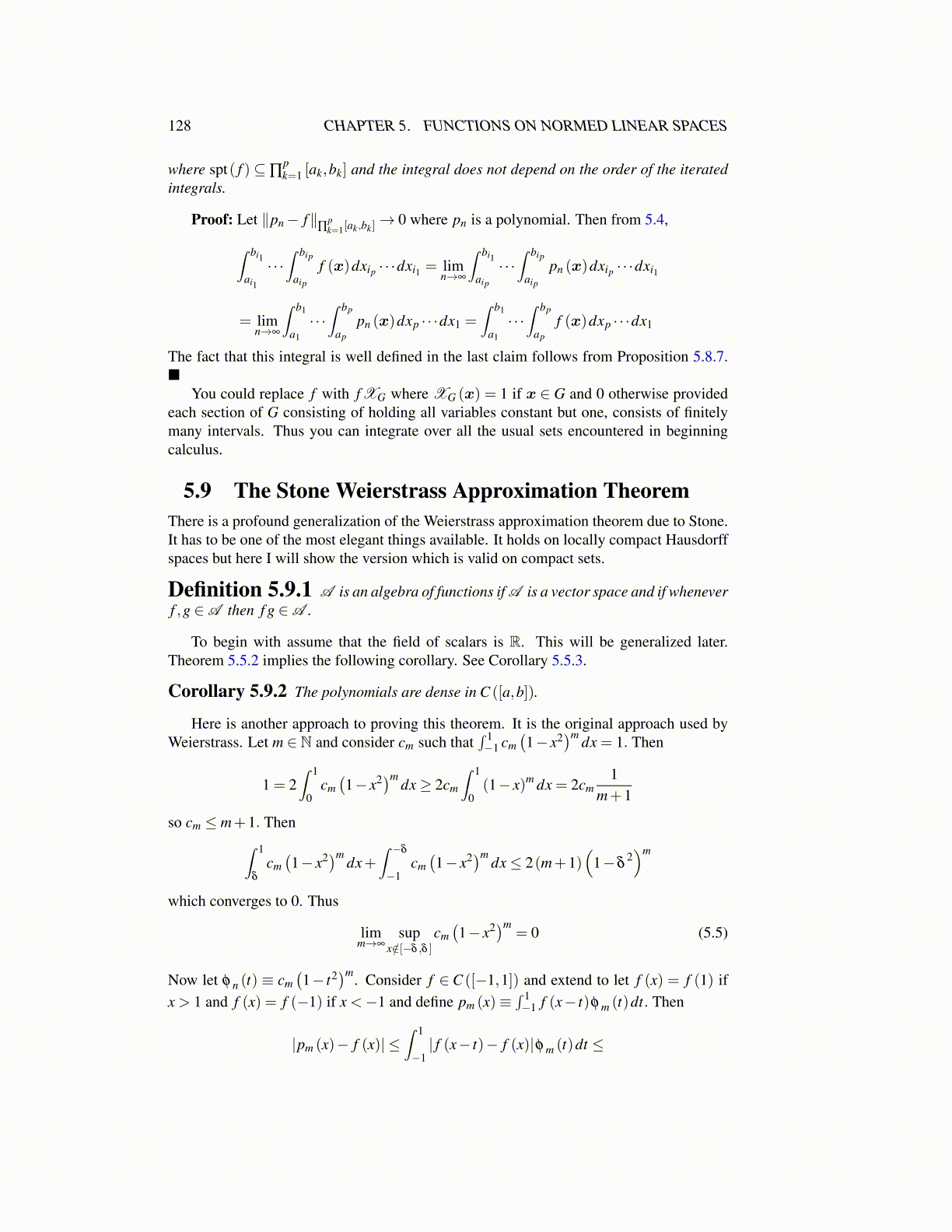
128 CHAPTER 5. FUNCTIONS ON NORMED LINEAR SPACES
where spt( f )⊆∏pk=1 [ak,bk] and the integral does not depend on the order of the iterated
integrals.
Proof: Let ∥pn− f∥∏
pk=1[ak,bk]
→ 0 where pn is a polynomial. Then from 5.4,
∫ bi1
ai1
· · ·∫ bip
aip
f (x)dxip · · ·dxi1 = limn→∞
∫ bi1
aip
· · ·∫ bip
aip
pn (x)dxip · · ·dxi1
= limn→∞
∫ b1
a1
· · ·∫ bp
ap
pn (x)dxp · · ·dx1 =∫ b1
a1
· · ·∫ bp
ap
f (x)dxp · · ·dx1
The fact that this integral is well defined in the last claim follows from Proposition 5.8.7.■
You could replace f with f XG where XG (x) = 1 if x ∈ G and 0 otherwise providedeach section of G consisting of holding all variables constant but one, consists of finitelymany intervals. Thus you can integrate over all the usual sets encountered in beginningcalculus.
5.9 The Stone Weierstrass Approximation TheoremThere is a profound generalization of the Weierstrass approximation theorem due to Stone.It has to be one of the most elegant things available. It holds on locally compact Hausdorffspaces but here I will show the version which is valid on compact sets.
Definition 5.9.1 A is an algebra of functions if A is a vector space and if wheneverf ,g ∈A then f g ∈A .
To begin with assume that the field of scalars is R. This will be generalized later.Theorem 5.5.2 implies the following corollary. See Corollary 5.5.3.
Corollary 5.9.2 The polynomials are dense in C ([a,b]).
Here is another approach to proving this theorem. It is the original approach used byWeierstrass. Let m ∈ N and consider cm such that
∫ 1−1 cm
(1− x2
)m dx = 1. Then
1 = 2∫ 1
0cm(1− x2)m
dx≥ 2cm
∫ 1
0(1− x)m dx = 2cm
1m+1
so cm ≤ m+1. Then∫ 1
δ
cm(1− x2)m
dx+∫ −δ
−1cm(1− x2)m
dx≤ 2(m+1)(
1−δ2)m
which converges to 0. Thus
limm→∞
supx/∈[−δ ,δ ]
cm(1− x2)m
= 0 (5.5)
Now let φ n (t) ≡ cm(1− t2
)m. Consider f ∈ C ([−1,1]) and extend to let f (x) = f (1) ifx > 1 and f (x) = f (−1) if x <−1 and define pm (x)≡
∫ 1−1 f (x− t)φ m (t)dt. Then
|pm (x)− f (x)| ≤∫ 1
−1| f (x− t)− f (x)|φ m (t)dt ≤